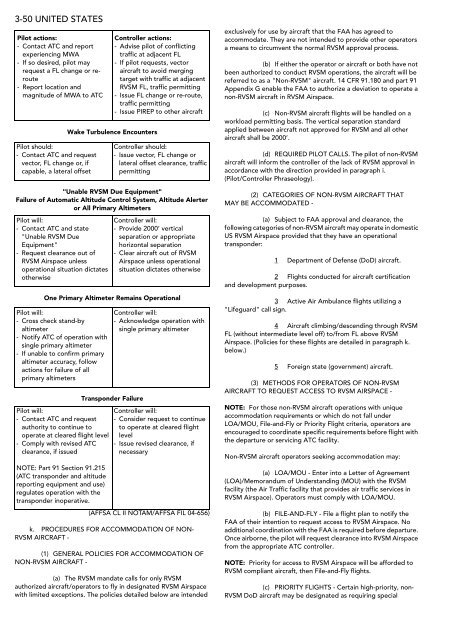NORTH AND SOUTH AMERICA - CNATRA - The US Navy
NORTH AND SOUTH AMERICA - CNATRA - The US Navy
NORTH AND SOUTH AMERICA - CNATRA - The US Navy
You also want an ePaper? Increase the reach of your titles
YUMPU automatically turns print PDFs into web optimized ePapers that Google loves.
3-50 UNITED STATES<br />
Pilot actions:<br />
- Contact ATC and report<br />
experiencing MWA<br />
- If so desired, pilot may<br />
request a FL change or reroute<br />
- Report location and<br />
magnitude of MWA to ATC<br />
Pilot should:<br />
- Contact ATC and request<br />
vector, FL change or, if<br />
capable, a lateral offset<br />
Wake Turbulence Encounters<br />
"Unable RVSM Due Equipment"<br />
Failure of Automatic Altitude Control System, Altitude Alerter<br />
or All Primary Altimeters<br />
Pilot will:<br />
-Contact ATC and state<br />
"Unable RVSM Due<br />
Equipment"<br />
- Request clearance out of<br />
RVSM Airspace unless<br />
operational situation dictates<br />
otherwise<br />
One Primary Altimeter Remains Operational<br />
Pilot will:<br />
- Cross check stand-by<br />
altimeter<br />
- Notify ATC of operation with<br />
single primary altimeter<br />
- If unable to confirm primary<br />
altimeter accuracy, follow<br />
actions for failure of all<br />
primary altimeters<br />
Pilot will:<br />
- Contact ATC and request<br />
authority to continue to<br />
operate at cleared flight level<br />
- Comply with revised ATC<br />
clearance, if issued<br />
NOTE: Part 91 Section 91.215<br />
(ATC transponder and altitude<br />
reporting equipment and use)<br />
regulates operation with the<br />
transponder inoperative.<br />
Transponder Failure<br />
Controller actions:<br />
- Advise pilot of conflicting<br />
traffic at adjacent FL<br />
- If pilot requests, vector<br />
aircraft to avoid merging<br />
target with traffic at adjacent<br />
RVSM FL, traffic permitting<br />
- Issue FL change or re-route,<br />
traffic permitting<br />
- Issue PIREP to other aircraft<br />
Controller should:<br />
- Issue vector, FL change or<br />
lateral offset clearance, traffic<br />
permitting<br />
Controller will:<br />
- Provide 2000’ vertical<br />
separation or appropriate<br />
horizontal separation<br />
- Clear aircraft out of RVSM<br />
Airspace unless operational<br />
situation dictates otherwise<br />
Controller will:<br />
- Acknowledge operation with<br />
single primary altimeter<br />
Controller will:<br />
- Consider request to continue<br />
to operate at cleared flight<br />
level<br />
- Issue revised clearance, if<br />
necessary<br />
(AFFSA CL II NOTAM/AFFSA FIL 04-656)<br />
k. PROCEDURES FOR ACCOMMODATION OF NON-<br />
RVSM AIRCRAFT -<br />
(1) GENERAL POLICIES FOR ACCOMMODATION OF<br />
NON-RVSM AIRCRAFT -<br />
(a) <strong>The</strong> RVSM mandate calls for only RVSM<br />
authorized aircraft/operators to fly in designated RVSM Airspace<br />
with limited exceptions. <strong>The</strong> policies detailed below are intended<br />
exclusively for use by aircraft that the FAA has agreed to<br />
accommodate. <strong>The</strong>y are not intended to provide other operators<br />
a means to circumvent the normal RVSM approval process.<br />
(b) If either the operator or aircraft or both have not<br />
been authorized to conduct RVSM operations, the aircraft will be<br />
referred to as a "Non-RVSM" aircraft. 14 CFR 91.180 and part 91<br />
Appendix G enable the FAA to authorize a deviation to operate a<br />
non-RVSM aircraft in RVSM Airspace.<br />
(c) Non-RVSM aircraft flights will be handled on a<br />
workload permitting basis. <strong>The</strong> vertical separation standard<br />
applied between aircraft not approved for RVSM and all other<br />
aircraft shall be 2000’.<br />
(d) REQUIRED PILOT CALLS. <strong>The</strong> pilot of non-RVSM<br />
aircraft will inform the controller of the lack of RVSM approval in<br />
accordance with the direction provided in paragraph i.<br />
(Pilot/Controller Phraseology).<br />
(2) CATEGORIES OF NON-RVSM AIRCRAFT THAT<br />
MAY BE ACCOMMODATED -<br />
(a) Subject to FAA approval and clearance, the<br />
following categories of non-RVSM aircraft may operate in domestic<br />
<strong>US</strong> RVSM Airspace provided that they have an operational<br />
transponder:<br />
1 Department of Defense (DoD) aircraft.<br />
2 Flights conducted for aircraft certification<br />
and development purposes.<br />
3 Active Air Ambulance flights utilizing a<br />
"Lifeguard" call sign.<br />
4 Aircraft climbing/descending through RVSM<br />
FL (without intermediate level off) to/from FL above RVSM<br />
Airspace. (Policies for these flights are detailed in paragraph k.<br />
below.)<br />
5 Foreign state (government) aircraft.<br />
(3) METHODS FOR OPERATORS OF NON-RVSM<br />
AIRCRAFT TO REQUEST ACCESS TO RVSM AIRSPACE -<br />
NOTE: For those non-RVSM aircraft operations with unique<br />
accommodation requirements or which do not fall under<br />
LOA/MOU, File-and-Fly or Priority Flight criteria, operators are<br />
encouraged to coordinate specific requirements before flight with<br />
the departure or servicing ATC facility.<br />
Non-RVSM aircraft operators seeking accommodation may:<br />
(a) LOA/MOU - Enter into a Letter of Agreement<br />
(LOA)/Memorandum of Understanding (MOU) with the RVSM<br />
facility (the Air Traffic facility that provides air traffic services in<br />
RVSM Airspace). Operators must comply with LOA/MOU.<br />
(b) FILE-<strong>AND</strong>-FLY - File a flight plan to notify the<br />
FAA of their intention to request access to RVSM Airspace. No<br />
additional coordination with the FAA is required before departure.<br />
Once airborne, the pilot will request clearance into RVSM Airspace<br />
from the appropriate ATC controller.<br />
NOTE: Priority for access to RVSM Airspace will be afforded to<br />
RVSM compliant aircraft, then File-and-Fly flights.<br />
(c) PRIORITY FLIGHTS - Certain high-priority, non-<br />
RVSM DoD aircraft may be designated as requiring special

















